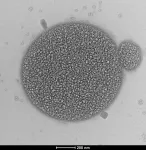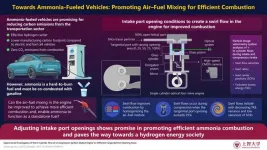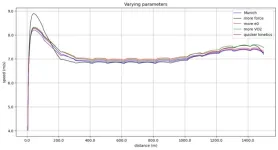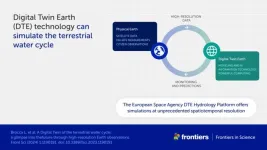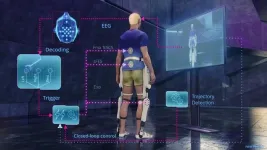(Press-News.org) Researchers built a model that can predict with 73.5% accuracy when a person will experience aesthetic chills: shivers, goosebumps, or a feeling of cold down the neck or spine elicited by aesthetic stimuli, such as beautiful music or an inspirational speech. Felix Schoeller and colleagues surveyed 2,937 people from Southern California, through an online platform, gathering data on their personalities, demographic backgrounds, and emotional state. The authors then exposed survey respondents to 40 emotion-evoking audiovisual clips sourced from social media, selected because commenters had reported experiencing aesthetic chills while watching and listening. The clips included choral performances, a commencement speech by a minister, readings of poems by Charles Bukowski and Mary Oliver, pop songs by Radiohead and Sigur Rós, and scenes from the films Hunger Games and Everything Everywhere All At Once, along with many others. The authors then built a model that identified demographic, psychological, and contextual factors that would predict whether a given person would experience aesthetic chills when watching or listening to a clip. People who reported being alert and in a good mood were more likely to feel chills than those who were tired or in a bad mood. Other factors that correlated with high probabilities of experiencing chills were being 35–44 years old, being male, being a Democrat, and having a graduate degree. Psychological characteristics such as extraversion and conscientiousness were also predictive of experiencing chills, as were high scores on specialized psychological scales that measure a person’s propensity to be emotionally moved (the Kama Muta Frequency Scale) and absorbed in the moment (the Modified Tellegen Absorption Scale). According to the authors, additional research into how emotional experiences are shaped by psychological, demographic, and cultural variables could eventually inform the use of aesthetic chills as a non-pharmaceutical treatment for affective disorders such as depression.
Examples of goosebump-inducing stimuli are available at the project website: http://chillsdb.com.
END
Predicting who will experience aesthetic chills
2024-03-05
ELSE PRESS RELEASES FROM THIS DATE:
Possible ‘Trojan Horse’ found for treating stubborn bacterial infections
2024-03-05
PULLMAN, Wash. – Bacteria can be tricked into sending death signals to stop the growth of their slimy, protective homes that lead to deadly infections, a new study demonstrates.
The discovery by Washington State University researchers could someday be harnessed as an alternative to antibiotics for treating difficult infections. Reporting in the journal, Biofilm, the researchers used the messengers, which they named death extracellular vesicles (D-EVs), to reduce growth of the bacterial communities by up to 99.99% in laboratory experiments.
“Adding the death extracellular vesicles to ...
AI art and human creativity
2024-03-05
Text-to-image generative AI systems like Midjourney, Stable Diffusion, and DALL-E can produce images based on text prompts that, had they been produced by humans, would plausibly be judged as “creative.” Some artists have argued that these programs are a threat to human creativity. If AI comes to be relied on to produce most new visual works, drawing on what has been done before, creative progress could stagnate. Eric Zhou and Dokyun “DK” Lee investigated the impact of text-to-image AI tools on human creativity, seeking to understand ...
Decoding cryptocurrency regulation in the legibility framework
2024-03-05
Since its introduction, cryptocurrency governance has been one of the most controversial global financial topics. While some countries have established elaborate regulations for cryptocurrencies, many countries are still reluctant to oversee the markets, and some have outright banned them. Most studies suggest that public agencies naturally want to regulate markets and bring them into their purview. However, the significant differences in cryptocurrency regulation over the world call this view into question. Moreover, these differences cannot be explained by the development ...
Ammonia-powered engines: A path to cleaner and more efficient transportation
2024-03-05
While the transportation sector has witnessed a dramatic shift toward electric vehicles (EVs), the idea of using hydrogen as a clean and efficient fuel for transportation has been explored for many decades. These vehicles emit water on combustion, and since they are based on the production of existing engine vehicles, they are expected to have a lower manufacturing carbon footprint than EVs. However, storing and transporting hydrogen requires high pressures and low temperatures, which are energy-intensive processes. To address this, ammonia has ...
Running performance helped by mathematical research
2024-03-05
How to optimise running? A new mathematical model1 has shown, with great precision, the impact that physiological and psychological parameters have on running performance and provides tips for optimised training. The model grew out of research conducted by a French-British team including two CNRS researchers2, the results of which will appear on March 5th 2024 in the journal Frontiers in Sports and Active Living.
This innovative model was developed thanks to extremely precise data3 from the performances of Matthew Hudson-Smith (400m), Femke Bol (400m), and ...
New ‘digital twin’ Earth technology could help predict water-based natural disasters before they strike
2024-03-05
The water cycle looks simple in theory — but human impacts, climate change, and complicated geography mean that in practice, floods and droughts remain hard to predict. To model water on Earth, you need incredibly high-resolution data across an immense expanse, and you need modeling sophisticated enough to account for everything from snowcaps on mountains to soil moisture in valleys. Now, scientists funded by the European Space Agency have made a tremendous step forward by building the most detailed models created to date.
“Simulating ...
Sweetened drinks linked to atrial fibrillation risk
2024-03-05
Research Highlights:
An analysis of health data in the UK Biobank found a 20% higher risk of irregular heart rhythm, known as atrial fibrillation, among people who said they drank two liters or more per week (about 67 ounces) of artificially sweetened drinks. The risk was 10% higher among people who said they drank similar amounts of sugar-sweetened beverages.
Drinking one liter (about 34 ounces) or less of pure juice per week, such as 100% orange or vegetable juice, was associated with an 8% lower risk of atrial fibrillation.
The observational study could not confirm that sweetened drinks cause irregular heart rhythms.
Embargoed ...
Hazardous heat and humidity is widespread in US jails and prisons, and climate change is worsening conditions
2024-03-05
An estimated 1.8 million incarcerated people in the United States have been recently exposed to a dangerous combination of heat and humidity, and on average experience 100 days of these conditions each year—many of them in the 44 states that do not provide universal air conditioning to inmates. Tracking with climate change, in recent decades, the number of dangerous humid heat days in carceral facilities has increased, with those in the south experiencing the most rapid warming.
The findings by researchers at Columbia University Mailman School of Public Health, Montana State University, ...
8 in 10 lizards could be at risk due to deforestation
2024-03-05
In Colorado, people flock to the Rocky Mountains when the summer heat gets unbearable. Animals seek shelter too when temperatures become extreme, and forests serve as critical sanctuaries for small tree-dwelling animals like lizards.
In a new study published March 5 in the journal Nature Climate Change, scientists from the University of Colorado Boulder and Tel Aviv University in Israel revealed that deforestation combined with climate change could negatively impact 84% of North America’s lizards by ...
Major neurotech hub in Milan announced
2024-03-05
The IRCCS San Raffaele Hospital and the Vita-Salute San Raffaele University announced the launch of a long-term partnership with the recently established Nicolelis Institute for Advanced Brain Studies of the Brazilian Alberto Santos Dumont Association for Research Support (AASDAP, www.aasdap.org.br) aimed at creating a state-of-the-art Neurotech Hub on their campus in the city of Milan. Resulting from a two-year planning process, that included the development of a comprehensive Master Plan, the San Raffaele Neurotech Hub will be the first initiative of this kind in Europe focused on deploying ...
